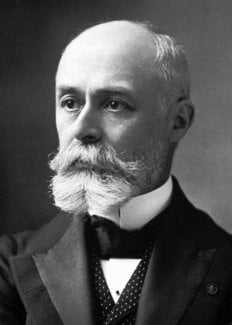Henri Becquerel
Biographical

Antoine Henri Becquerel was born in Paris on December 15, 1852, a member of a distinguished family of scholars and scientists. His father, Alexander Edmond Becquerel, was a Professor of Applied Physics and had done research on solar radiation and on phosphorescence, while his grandfather, Antoine César, had been a Fellow of the Royal Society and the inventor of an electrolytic method for extracting metals from their ores. He entered the Polytechnic in 1872, then the government department of Ponts-et-Chaussées in 1874, becoming ingénieur in 1877 and being promoted to ingénieur-en-chef in 1894. In 1888 he acquired the degree of docteur-ès-sciences. From 1878 he had held an appointment as an Assistant at the Museum of Natural History, taking over from his father in the Chair of Applied Physics at the Conservatoire des Arts et Metiers. In 1892 he was appointed Professor of Applied Physics in the Department of Natural History at the Paris Museum. He became a Professor at the Polytechnic in 1895.
Becquerel’s earliest work was concerned with the plane polarization of light, with the phenomenon of phosphorescence and with the absorption of light by crystals (his doctorate thesis). He also worked on the subject of terrestrial magnetism. In 1896, his previous work was overshadowed by his discovery of the phenomenon of natural radioactivity. Following a discussion with Henri Poincaré on the radiation which had recently been discovered by Röntgen (X-rays) and which was accompanied by a type of phosphorescence in the vacuum tube, Becquerel decided to investigate whether there was any connection between X-rays and naturally occurring phosphorescence. He had inherited from his father a supply of uranium salts, which phosphoresce on exposure to light. When the salts were placed near to a photographic plate covered with opaque paper, the plate was discovered to be fogged. The phenomenon was found to be common to all the uranium salts studied and was concluded to be a property of the uranium atom. Later, Becquerel showed that the rays emitted by uranium, which for a long time were named after their discoverer, caused gases to ionize and that they differed from X-rays in that they could be deflected by electric or magnetic fields. For his discovery of spontaneous radioactivity Becquerel was awarded half of the Nobel Prize for Physics in 1903, the other half being given to Pierre and Marie Curie for their study of the Becquerel radiation.
Becquerel published his findings in many papers, principally in the Annales de Physique et de Chimie and the Comptes Rendus de l’Academie des Sciences.
He was elected a member of the Academie des Sciences de France in 1889 and succeeded Berthelot as Life Secretary of that body. He was a member also of the Accademia dei Lincei and of the Royal Academy of Berlin, amongst others. He was made an Officer of the Legion of Honour in 1900.
He was married to Mlle. Janin, the daughter of a civil engineer. They had a son Jean, b. 1878, who was also a physicist: the fourth generation of scientists in the Becquerel family.
Antoine Henri Becquerel died at Le Croisic on August 25, 1908.
This autobiography/biography was written at the time of the award and first published in the book series Les Prix Nobel. It was later edited and republished in Nobel Lectures. To cite this document, always state the source as shown above.
The Nobel Foundation's copyright has expired.Nobel Prizes and laureates
Six prizes were awarded for achievements that have conferred the greatest benefit to humankind. The 14 laureates' work and discoveries range from quantum tunnelling to promoting democratic rights.
See them all presented here.
